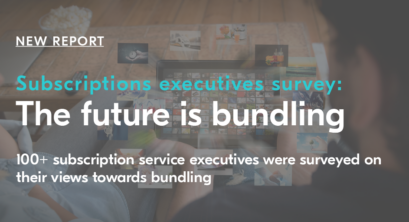Super Bundling grows revenue and reduces churn, concludes new report
by Giles Tongue

A game-changing eight in ten (81%) of industry leaders believe Super Bundling is the future for the subscription services economy.
That’s according to research — The Future is Bundling — conducted by StreamTV on behalf of Bango which surveyed more than 100 key industry decision-makers about bundling and the future direction for digital services.
The research report also found that seven in ten (70%) believe the organization they represent should bundle their services with other content providers and subscription providers.
These findings from some of the biggest and brightest movers and shakers provide the clearest sign yet that the subscriptions industry is starting to move away from an increasingly outdated business model and is instead readying itself to embrace next-generation bundling — Super Bundling.
Consumers driving change in the subscription economy
As the report makes clear, part of that is due to the industry’s willingness to listen to — and respond to — growing ‘subscription fatigue’ among consumers.
“After more than a decade of signing up for over-the-top (OTT) video-on-demand (VOD) subscriptions, many [consumers] are growing weary,” said the report.
“Subscribers don’t want less choice; they want less admin. They want relief from paying multiple bills. They want the freedom to pause subscriptions easily — perhaps when their favorite series completes a season, or they go on a trip — and resume them when they desire.
“In short, they want fewer hassles and greater convenience,” it said.
And it’s supported by a survey finding which revealed that an overwhelming number of subscribers (93%) agree that the convenience of having all subscriptions in one place is ‘the ‘greatest consumer benefit of Super Bundling from subscription content hubs’.
Super Bundling grows subscribers and reduces churn
Although these customer insights are key to understanding the changes happening within the subscription economy, it is only part of the story.
Not only do business leaders now realize the dissatisfaction among consumers of a bundling model that’s past its sell-by date, they are also beginning to comprehend the opportunities Super Bundling presents. In other words, adopting Super Bundling isn’t just about adapting to changing consumer demands — there are tangible business benefits to have as well.
According to the report, almost three-quarters (73%) of those surveyed said addressing the needs of customers via Super Bundling would lead to subscriber growth, while more than two-thirds (68%) said it would lower churn.
When asked to go into more detail, 48% said it would improve the stickiness of their service, 46% said it would reduce the cost of acquiring new customers and 39% said it would improve the lifetime value of customer relationships. As industry insights go, this is gold dust.
Overcoming challenges is key to success
Despite these overwhelming drivers for change, the report did uncover some reservations to change.
For some (36%), it lies in a reluctance to embrace change — particularly concerning the potential loss of direct relationships with end users — even though a similar number (34%) acknowledge the difficulty of building a direct-to-consumer (D2C) service.
For others (34%), it’s the perceived complexity of integrating their service into a subscriptions hub.
Happily, both of these concerns can be addressed.
First, signing up to a Super Bundling platform can be in addition to existing D2C models rather than instead of.
Second, the Digital Vending Machine® SaaS product provides everything that’s needed for subscription bundling and payments, enabling providers to quickly reach new customers and markets with speed and scale.
As the report makes clear: “Building your own Super Bundling content hub will be a vital future source of revenue for subscription services as this ‘one-stop shop’ approach gives content providers a strong competitive advantage.
“The bottom line is subscription service organizations and content providers are keenly interested in bundling to grow subscriptions and revenue as well as reduce churn. There is near complete agreement that their future depends on a successful bundling strategy,” it said.
To find out more — and to download your copy of The Future is Bundling — click here.
Subscribe to our newsletter
Get the latest subscription bundling news and insights delivered straight to your inbox.



